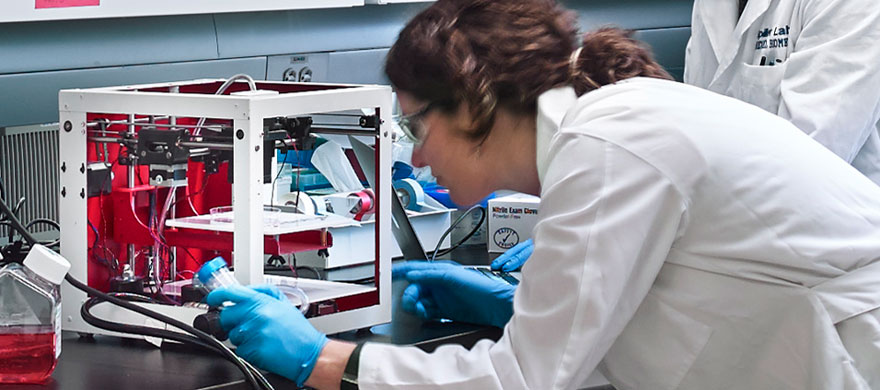What is Translational Research?

Have you ever been curious how amazing new discoveries in science and technology reach medical professionals to save lives and improve healthcare? The process is called translational research and it applies the latest discoveries in science to solve unmet medical needs bringing lifesaving solutions into the hands of clinicians and medical professionals.
While basic research in the biomedical field seeks to ‘understand’, translational research seeks to ‘fix’. Translational research, or ‘use-inspired’ research, builds upon basic scientific research synthesizing knowledge to design a new or improved drug, device, diagnostic, or behavioral intervention.
The goal of translational research is to advance the project towards the next step in translation: pre-clinical research, clinical research, clinical implementation, and public health stages. To accomplish this, translational research requires close collaboration of engineers, scientists, and clinicians working as a team across traditional boundaries bridging government agencies, hospitals, academia, and industry.
Clinical vs. Translational Research
The two terms are interlinked. Clinical research broadly covers the study of human health and illness, testing new methods of diagnosis, prevention, and treatment. Translational research focuses more on the achievement of improved health outcomes of a particular scientific discovery.
Translational research bridges the gap between basic research and clinical research. Clinical research, therefore, is a critical step in the translational process, as this stage determines if new medical solutions are both effective and safe for widespread clinical use.
Why is Translational Research Important?
Scientific discovery outpaces the ability to translate discoveries to life saving solutions in the market. In fact, many scientific discoveries and observations do not advance down the development pipeline. With more talent and better leadership, translational research and lifesaving observations and insights are less likely to be ‘lost in translation’ because of factors such as funding, organizational barriers, and lack of technical expertise.
New approaches to translational research are accelerating innovations to reach the patient and improve population health sooner. When translational research succeeds, gaps in the medical care system are closed, lives are saved and lives are enhanced. Higher quality healthcare for all leads to a healthier and a more economically viable population.
Drexel Coulter Translational Research Partnership Program
The Drexel Coulter Translational Research Partnership Program promotes, develops, and supports innovations to improve patient care. The program provides mentoring, project management, and funding to promising translational projects with the goal of moving innovative technologies to clinical application through commercialization. The ultimate goal of this partnership is to develop health care solutions that address unmet or underserved clinical needs and lead to improvements in patient health care.
Evidenced by the award of Coulter-Drexel Translational Research Partnership Program, Drexel Biomed is a national best practice in translational research recognized by the Coulter Foundation.
Drexel Biomed's Impact in Translational Research
By bridging traditional organizational structures in the sciences, medicine, engineering and entrepreneurship, Drexel Biomed has become a center of gravity for translational research that not only creates life-saving solutions but also leads to partnerships with regional and global commercialization communities to bring these solutions to market.
Drexel Biomed is a leader in creating intellectual properties poised for commercialization with a total of 125 patents, which includes 90 US and 35 foreign issued patents. We have forged relationships with a network of partners bridging academia, industry and government to harness our combined potential regionally, nationally and internationally and to fulfill our social contract. Global Innovation Partnership (GIP) is an endowed initiative of Drexel University. Hosted by the School of Biomedical Engineering, Science and Health Systems, GIP is focused on academic programs that enable partners from research, entrepreneurship, business and investment communities to accelerate life saving solutions to healthcare worldwide.
Showcase: Translational Research in Action
Below are several examples of translational research, and have been developed through interdisciplinary collaboration of biomedical engineers, scientists, doctors, entrepreneurs, patent experts, as well as government authorities across traditional institutional boundaries. See how each project addresses a critically unmet medical need with an innovative technology or medical device to save lives or enhance human health.
Breast Cancer Detection / Piezoelectric Fingers / Biosensors Platform
A new device may enable breast cancer screening and cancer detection in populations where mammography is not widely available or successful, including women in developing countries, and those under the age of 40. Dr. Wan Shih with Dr. Wei-Heng Shih and their team at Drexel University have developed a non-invasive, radiation-free, portable device used for breast cancer detection based on measurements of tissue elasticity. The goal of the project is to develop a portable, radiation-free, breast scanning system that not only is capable of locating small tumors but also able to predict tumor malignancy.
Featured by

Chronic Wound Healing / Biomedical Ultrasonics: Sensors Platform
Drexel researchers have developed a light-weight, wearable low-power, low-frequency ultrasound applicator that can be used for the treatment of chronic wounds. This device has been tested in a limited clinical study, in which chronic venous ulcer wounds were treated at Dr. Weingarten’s Wound Management Center, Drexel University College of Medicine. “There is no other existing treatment you can compare it with,” said Peter Lewin, PhD, the project’s principal investigator and the Richard B. Beard Distinguished University Professor in the School of Biomedical Engineering, Science and Health Systems. “If we can prove this is effective for a large group of patients, then we have the potential to solve a very costly and debilitating health problem.”
Featured by

Traumatic Brain Injury / Near Infrared Based Optical Imaging Platform
A Drexel team and InfraScanner, a local medical firm, have committed to a contract with the U.S. Navy and Marine Corps to work on a device that will evaluate brain injuries. The device uses near-infrared light to detect brain bleeds. Using a physics equation, Infrascanner can tell the volume of the blood in the brain. Although some of the light is absorbed in the brain tissue, the rest returns to the device with information. Drexel biomedical engineers participated in the design and testing of the original Infrascanner and will utilize their expertise in the optical brain imaging technology they've been developing.
Utilized by

Graduate Opportunities: Coulter Fellowship Program
The Coulter Fellowship Program is an innovative opportunity to work with research teams, as well as to seamlessly learn about the industry landscape for upcoming biomedical technologies. Qualified students get hands on experience with the commercialization process in translating a technology from university laboratories to the real world.
Learn How to Apply